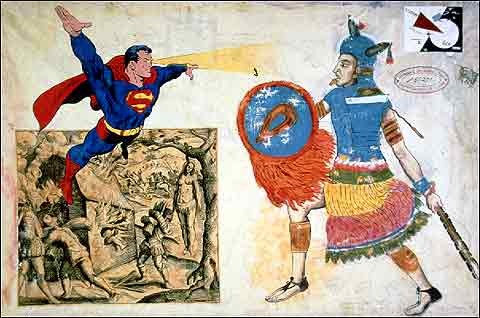Los Angeles County Museum of Art ,
May 13, 2001 - Aug 26, 2001
Los Angeles, CA, USA
Curatorial Statement
by Virginia Fields
The development of the exhibition The Road to Aztlan: Art from a Mythic Homeland began in 1991 with a conversation with Karl Taube, a professor of anthropology at the University of California, Riverside. He suggested that the interaction between the American Southwest and Mexico might make an interesting topic for an exhibition, and when he proposed the title The Road to Aztlan, I knew that a thought-provoking show could result. Aztlan for me connoted the legendary homeland associated not only the Aztecs of the 15th and 16th centuries, but also with the Chicano movement born in the late 1960s. In 1995 I began exploring the chronological and cultural links between these eras with art historian and curator Victor Zamudio-Taylor. Together we further refined the project themes.The framework of interaction between the American Southwest and Mexico was expanded to include cultural exchanges that took place over the course of nearly 2,000 years, beginning with the introduction of maize agriculture from Mexico in the first millennium BC, continuing with the arrival and impact of the Spanish in the 16th century, and culminating with the revival of the concept of Aztlan by Chicano activists in the 1960s. Under the auspices of a grant from the Ethnic Arts Council of Los Angeles, I investigated museum collections throughout the Southwest and central Mexico and found intriguing examples of the connections between the regions. A grant from the National Endowment for the Humanities allowed us to plan two two-day conferences that brought together archaeologists, art historians, artists, and educators to discuss the eras of contact between the Southwest and Mexico. The dialogue proved invaluable in clarifying the exhibition’s core themes, such as centrality of place, mythic origins, and shared cultural features ç including a ballgame, hero twins, and a plumed serpent. Many of the discussion participants served as exhibition catalogue authors, writing essays on their respective specialties. The Road to Aztlan reflects an ongoing story of collaboration with scholars, artists, and the community ç all engaged in the quest for mythic origins. * This text was reproduced from the Curatorial Column in At the Museum, March/April 2001, with permission from the Los Angeles County Museum of Art. About the Curator
Before receiving her Ph.D. in Latin American Studies from the University of Texas at Austin in 1989, Dr. Fields was curator of the Native American collection at the Clarke Memorial Museum in Eureka, California. She has taught as a lecturer in the fields of pre-Columbian and Native American art at the University of California, Santa Barbara, and the University of Southern California, and as an assistant professor at California State University, Northridge. Her publications include catalogues on Karuk basketry and Mayan ceramics as well as articles on aspects of pre-Columbian art and culture. Dr. Fields co-curated the exhibition Painting the Maya Universe: Royal Ceramics of the Classic Period at LACMA and most recently supervised the installation of Ancient West Mexico: Art and Archaeology of the Unknown Past. She is presently organizing an exhibition on the concept of divine kingship among the ancient Maya, which will take place at LAMCA in 2004.
|









